Shihding, Nikon Scene Modes, & Elusive Hiking Trails
My goal on Saturday was to hike an interesting trail near the little town of Shihding just outside of Taipei. Things didn’t quite work out for the hike, but I had an interesting day nonetheless.
I set off on my scooter pretty early after making sure I had sunscreened all the important bits of my body. I didn’t bring a change of clothing since I didn’t plan on staying overnight anywhere. Shihding is less than an hour away from my apartment in downtown Taipei, and I figured it would easy enough to drive back at the end of the day. If I did find a good place to stay (unlikely), I would just put up with stinky clothes for the second day.
The drive out was glorious as it always is. There’s nothing like the freedom a scooter gives you here in Taiwan. Getting to Shihding is pretty easy once you know how. I follow my usual route out of Taipei as if I am driving to Pingxi. However, at a main intersection – one with a very popular 7-11 – instead of turning left, I go right. Shihding is just a few kilometers up that road. You have to be careful at that intersection, though. Anyone who has driven that route will know what I’m talking about. It is a favorite hangout for cyclists, scooter drivers, and motorcycle drivers as they are out driving around on the mountain roads. There are so many bicycles, scooters, motorcycles, and cars parked there that they practically overflow right onto the main road. It’s a very confusing intersection to begin with. It’s not clear who has the right of way, and traffic comes at you from all directions. Add all the bizarrely parked vehicles and it’s crazy confusing.
My plan was to stop at this 7-11 for a morning coffee and to relax, but there were so many people there that I changed my mind and I kept driving. (Interesting that nearby was a huge tea/coffee shop with a beautiful balcony overlooking a gorgeous river. This tea/coffee shop – as are so many in Taiwan – was shuttered up and closed – out of business. Meanwhile, the 7-11 right beside it is so busy that you can’t even get in the doors.) A hundred meters or so up the road, I spotted a nice suspension bridge and I pulled over to take a stroll and take some pictures. It was a beautiful spot and I took a lot of pictures of the river and the rocks and the surrounding mountains. Unfortunately, none of them turned out. I’m not sure what I did wrong with my camera, but I definitely did something wrong. The pictures were horrible and I ended up deleting almost all of them.
After this bridge, I went through a short tunnel and in a few minutes I was at the town of Shihding. Shihding has become very popular with daytrippers from Taipei, and it is a great place to hang out and take pictures. I’ve forgotten the history of the town, but it has a somewhat restored old street with lots of quaint shops. Best of all, though, is that two rivers run through the town and they meet right in the center. There are walkways right down at the edges of the rivers, and you can walk down various sets of precarious steps and explore the rivers. It’s a great place to take pictures – which I did. Unfortunately, none of these pictures turned out either and I deleted most of them. From a photography point of view, it was a very frustrating day. I recently bought a Nikon D7000 and apparently it is too much for me. I haven’t figured out how to use it properly. I do get awesome pictures from time to time, but it’s usually just lucky chance. I don’t know why those pictures end up great and at other times I get very poor exposures. I can’t look at a scene and then choose the appropriate settings to suit the scene. In fact, I get consistently much better results from my little Canon Elph point-and-shoot – which cost me a mere NT$5,000. I might as well have saved myself the effort of carrying my giant DSLR around all day and just used the waif-like Elph.
I think I know what the problem was. For some reason, I had turned on the Active D-Lighting on the Nikon and set it to High. I did that partially out of curiosity. I like vivid colors and I like to see detail in shadows and highlights. I had used Active D-Lighting before, but I had never used the High setting. It never seemed necessary. I just thought it would be useful here because there was such a wide range of lighting. There were lots of dark shadows under the various bridges and buildings. I wanted to bring out the detail in those shadows. The end result was 100% the opposite. All the dark areas weren’t brightened at all. They ended up being pitch black! There was no detail there at all. The pictures were just unpleasant and dark everywhere with little detail and no depth at all. This surprised me because the point of D-Lighting is to bring out detail.
To be honest, my overall experience with the D7000 has been more frustrating than anything else. I’m certainly no expert at photography. I tend to shoot in Aperture Priority and that’s about it. I find that Nikon DSLRs overexpose almost all the time, so I might dial in a tiny amount of exposure compensation. And that’s it. That’s pretty much all I do. This technique has brought me good results in the past when I shot with slide film. And it brought me great results with my old Nikon D40X. But with the D7000, I just can’t seem to get it right. Aperture Priority seems to let me down all the time. To add insult to injury, I get much better results when I simply use the camera’s scene modes.
It’s a funny situation because most people dismiss those scene modes as something for amateurs and for people who don’t know what they’re doing. As you buy more and more expensive cameras, you get less scene modes. And the scene modes you get tend to be more hidden in the menu system. On the Nikon D5100, for example, various scene modes are right on the Mode Dial. This is because the D5100 is meant for regular consumers. When you jump up to the D7000, you still get some scene modes, but they are all grouped under one setting on the Mode Dial. Then you have to use one of the Control Wheels to choose one. They’re just a bit harder to access, but they’re still there. This is because the D7000 is aimed at more experienced photographers. (I’m guessing the D300s and the D800 have no scene modes at all.)
So what does it mean that the scene modes are much smarter than I am? I’m starting to use them more and more because my old standby – Aperture Priority – lets me down. I’m not sure what these scene modes are doing exactly, but it’s far more than I do on my own. And, when I think about it, that makes sense. In the old days when I shot with my Contax cameras with slide film, there weren’t so many options. All you could really set was the shutter speed and aperture. I used aperture priority and that was about it. You didn’t even have to choose your ISO because that was set by the film you purchased. You didn’t have to choose a white balance either, of course. That was also simply built into the film (as far as I understand it).
With these DSLRs, there are dozens and dozens of settings. Combine them, and you are talking about thousands upon thousands of options. It’s bewildering, to be honest: sharpening, contrast, brightness, hue, saturation – all of these can be fine-tuned. White balance can be micro-adjusted down to the tiniest degree of every individual color. I could go on and on just describing all the options available – just listing them – let alone talking about how to use them. How many of these options would have to be adjusted to get a nice portrait image as opposed to a landscape image? a shot of a dark forest as opposed to a bright beach? a city street as opposed to a shot of a river with sky? I certainly don’t have the time or knowledge to dive into the camera and make all these micro-adjustments every time I point my camera at a different type of subject. I got so frustrated with the results, that I decided one day to simply use the camera’s scene modes, and to my shock and surprise, my pictures were FAR better. Not just a little bit better but FAR FAR better. The conclusions were pretty obvious – the camera was much more complex than anything I’d used before, the settings really did make a big difference, and the camera’s programming was much, much smarter than I was.
And this really makes sense to me. For example, the Portrait Scene Mode on my D7000 is the result of the combined knowledge of dozens (hundreds? thousands?) of highly-skilled and knowledgeable people – photographers and technicians – at Nikon. I can’t compete with that knowledge base. I know that choosing a large aperture (f/1.4 or f/1.8 etc.) will give me a shallow depth of field and keep the subject’s face sharp and in focus while blurring the background. This can be pleasing for a portrait shot. That’s simple. But when you look at the Help section of my camera, it says that the Portrait Scene Mode “gives skin tone a smooth, natural feel.” And it does. It really does. I have no idea how it does. I assume it alters all these tiny settings deep in the camera to produce this nice skin tone. I can’t do that myself – I don’t know how. I don’t even know what settings the camera is changing to give this result.
The inevitable conclusion for me is that when shooting portraits, I’m better off using the camera’s Portrait Scene Mode rather than just simple Aperture Priority. I get better results. I’ve found that the camera’s Beach/Snow Scene Mode gives me better results when shooting at a beach than I can get on my own. I don’t know what the camera is doing to get those results, but they’re better results than I get on my own.
So in a way, the standard perspective on these Scene Modes – that they are for amateurs who don’t know what they are doing – is old-fashioned and out-dated. Cameras are becoming so complex that these scene modes out-perform me easily. To me, they seem to be more important as you buy more professional cameras, not less important. As you buy more professional cameras, you are given much more detailed and precise control over your camera’s features and settings. However, you reach a point where there is such a complexity of options that you simply don’t have time to set them all yourself – even if you knew how to set them. So the scene modes become more important. Right now, I wish my D7000 had MORE scene modes and I wish that they were easier to access. I’m willing to bet that if I had used the Landscape Scene Mode on my daytrip to Shihding, I would have ended up with awesome pictures instead of all the junk that I ended up deleting.
In going over my camera, I’m not sure, actually, which scene mode would apply to the normal photography I do while wandering around Taipei or any other city. I’m not shooting portraits. I’m not shooting landscapes per se. The other scene modes such as fireworks, pets, sports, kids, blossoms, autumn colors, etc., obviously don’t apply. I think Landscapes is the closest. Next time I’m just wandering around a place like Shihding, I’ll try the Landscapes Scene Mode and see what happens.
I spent quite a long time exploring Shihding. I had been there a couple of times before, but each time it feels different and I can never resist climbing down to the rivers and exploring. It’s great to be down there and looking up at all the crazy buildings leaning over above you. It feels a bit like a secret world. There’s a nice courtyard in the center of Shihding with lots of tables and you can buy a good cup of coffee or snacks and sit there and watch the world around you. At one point, I was VERY glad to also discover that there are public bathrooms right in the center of town, too.
After taking my couple of hundred of horrible pictures, I hopped back on my scooter to find the hiking trail. Three hours later, I was still looking. Turns out I had gone in the wrong direction. I’d gotten instructions online about how to find the start of the trail, and you were basically supposed to drive through Shihding and the trail will start at a temple. These directions, as with most directions in this life of mine, were not complete. There is a Y-intersection as soon as you reach the center of Shihding. You can go left or you can go right. Which direction is actually “going through” Shihding? I chose right because it seemed to be the continuation of the main road I was on. As it turned out, going right was, well, wrong. I should have gone left. When you turn right, you go across a bridge and go through the center of Shihding. That is NOT the direction you want to take if you are looking for the Huangdidian Trail. Instead, you should bear left when you reach that Y-intersection. (There’s a convenience store right on the corner of that intersection – either a Family Mart or a Hi-Life.) Then you will come across the aforementioned temple on your left very quickly. You are still pretty much right inside Shihding at this point. You haven’t “gone through” Shihding at all. There is a big parking lot right there. Or you can drive up the road on your right and after a few twists and turns you will come to another very large parking lot right beside the beginning of the main trail. You will recognize it by the signs and by the very wide cement steps that start there.
I did not see all this on my first attempt. As I said, I turned right and drove through Shihding and out the other side in my search for the temple and the trail. I saw lots of assorted trails and temples and other hikers, but I didn’t see the trail I was looking for. At least I didn’t think so. I turned left up an interesting-looking road and after a few minutes got some amazing views of the countryside and surrounding mountains. At that point, I decided to just keep driving and turn this into a scootering day as opposed to a hiking day. It was already getting late anyway, and after my long walks along the rivers in Shihding, I was already pretty tired and hot and sweaty.
This road climbed very high into the mountains and was a beautiful drive. It intersected with lots of other small roads leading in all kinds of interesting directions. These roads in the mountains continue to surprise me. There are so many of them and they are in extremely good condition. Backroads like these in Canada would be in progressively worse and worse shape until you would finally be on a potholed logging road leading into mud and wilderness. In Taiwan, these mountain backroads are perfectly paved and smooth and there seem to be no end to them. You can drive around for hours and find interesting things. There are lots of buildings and home-like structures up there, but I never quite know what these buildings are or what kind of people live up there or what they do there. It would be interesting to find out.
Continue on one of these backroads long enough and you will eventually pop out onto a larger road that you recognize. That’s why I have no problem simply driving without a clue where I am going. Taiwan is small enough that I eventually always end up somewhere I recognize. In this case, my mountain road ended at Highway 9 to Pinglin. I turned down that highway intending to drive to Pinglin for a cup of coffee there. Before I got there, though, I saw another interesting road leading down to a beautiful water reservoir or river formed by a dam and the Yongan Mountain Trail. I drove to the very bottom, spent an hour on the trail taking more horrible pictures that I deleted and then drove back up.
Before I got to Pinglin, I turned down another interesting road that took me along a river and an awesome cycling route. It looked like a beautiful area to explore with lots of hiking trails. I got completely disoriented and lost down there, but I kept driving and I eventually arrived back on Highway 9 just past Pinglin. It took me a few minutes to figure that out, but once I knew where I was I drove back to Pinglin and stopped off at a convenience store with the dozens of other cyclists, scooterers, and motorcyclists. In Pinglin, more than anywhere in Taiwan, you see how the convenience store culture has taken over from traditional culture. Pinglin is famous for its tea, and there are very inviting and cozy tea shops all along the main drag. These, however, are completely empty as both the 7-11 and the Hi-Life are standing-room only and you have to struggle to find a place to park your scooter.
I thought for a bit about staying in Pinglin overnight. There is a hotel/campground that I know of that is fairly reasonable. However, I had a feeling it would be raining the next day and staying overnight wouldn’t work out for the best. I hopped back on the scooter and zoomed along the 106 sideroad in the direction of Shihding. That’s another beautiful ride, and this is the route I would have been on had I turned left at the original Y-intersection in Shihding.
I went up and over the mountain ridge and then down into Shihding, and there, on my right now, was the temple with the entrance to the trails I had set out to find hours earlier. I turned into this temple and then made sure of the trail. I thought I might go back on Sunday (today) and complete the hike. If not, I’ll definitely go back in the near future. I’ll have a double purpose for that trip. I’ll take the exact same pictures in Shihding – this time with the Landscape Scene Mode – and I’ll do the hiking trail. Another weekend, though, as I’m spending all Sunday morning writing this…..
An hour later, after a quick stop at the public bathrooms in Shihding, I was back in Taipei downloading pictures to my computer and being horrified at what I was seeing. It was a good day and I came back – as I always do – with lots of new ideas for places to explore. Not sure when I’ll find the time.
Tags: D7000, Nikon, Nikon D7000, Scene Mode, scooter, Shihding, Taipei, Taiwan, temple

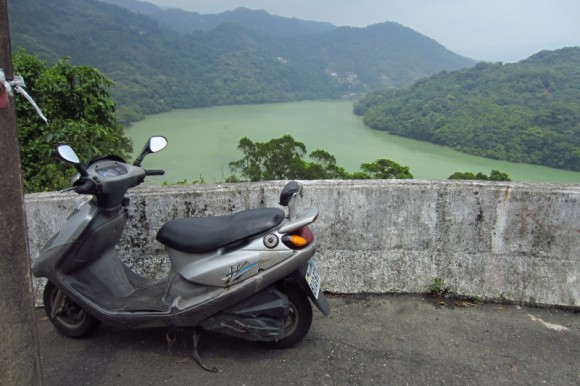
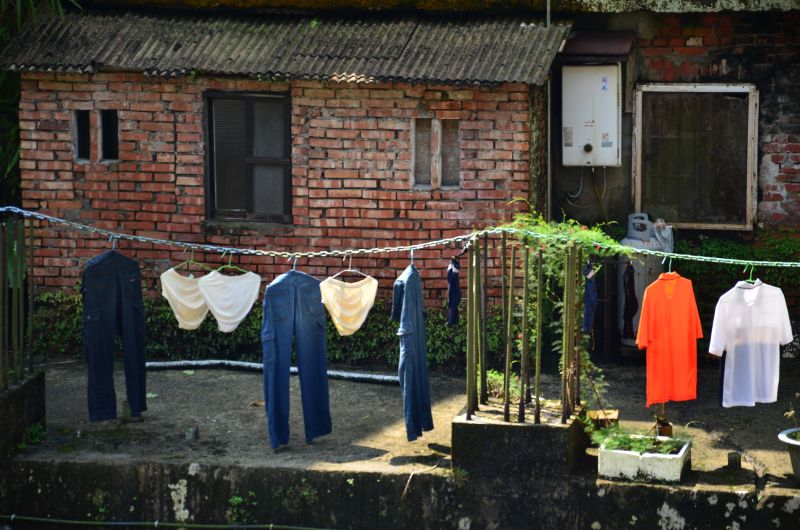
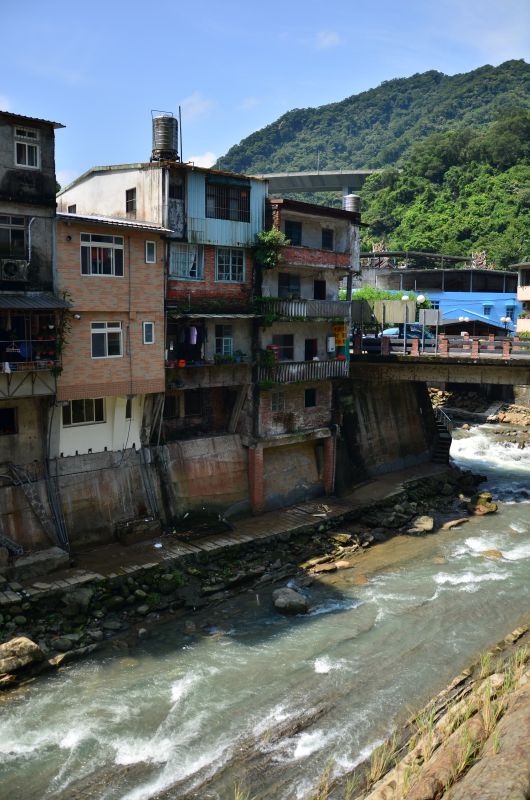
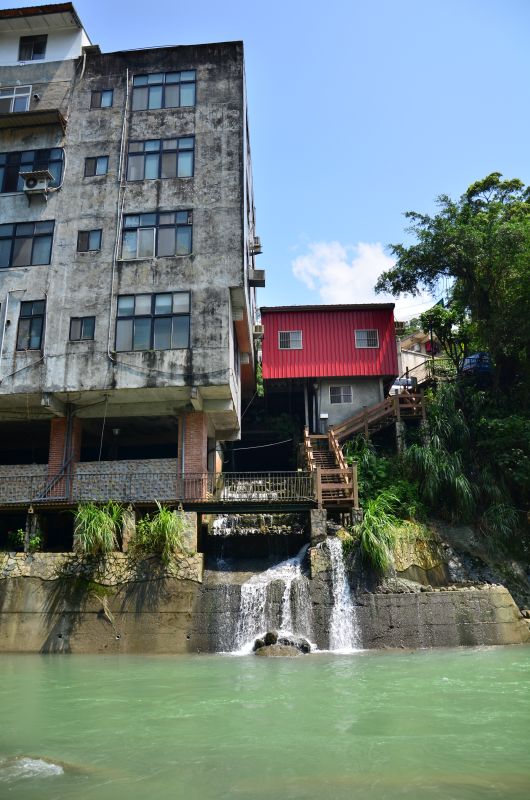


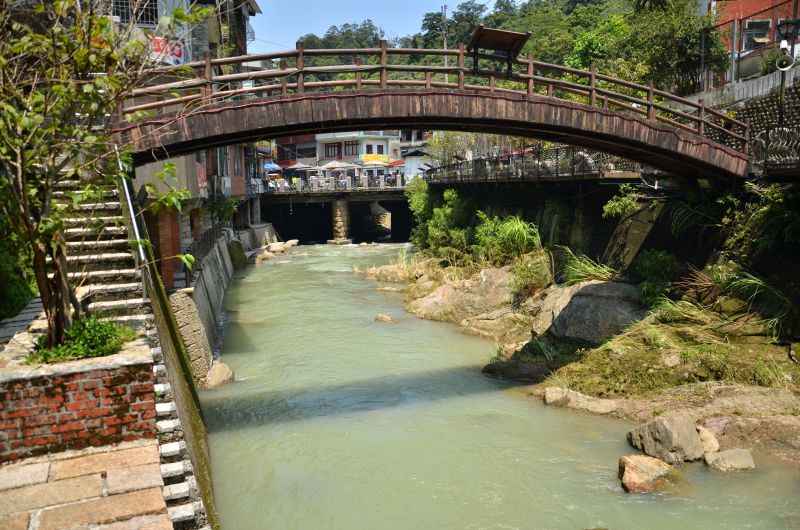

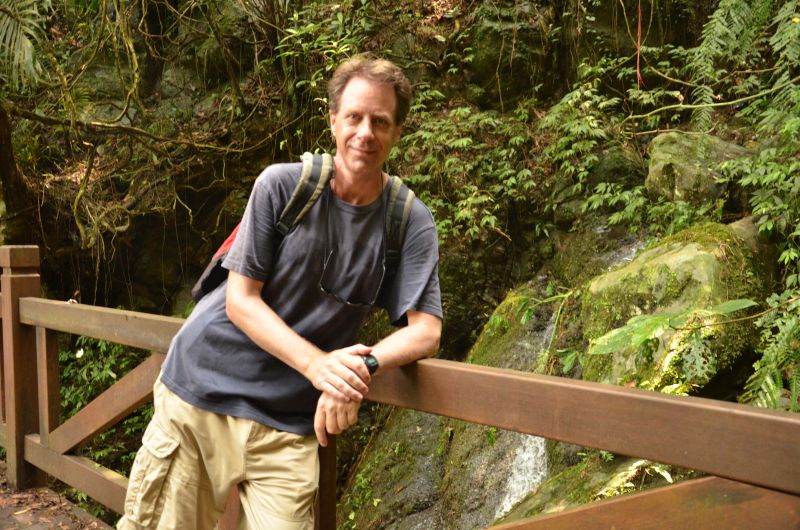

Shihding looks like a very small village, doesn’t it?
Yes, it does look like a small village. Of course, there is a lot more to Shihding than I’ve shown in these pictures. There are lots more streets behind the ones by the river and there are some big apartment buildings, schools, temples, and more. There is also the old street and the nice courtyard by the river. It’s a great place to sit and have a cup of coffee. Big highway 5 actually goes right over the top of Shihding on massive cement pillars. I really like Shihding. It’s an interesting place. There’s a set of old railway tracks going across the river with an old railway car and a statue of a miner on it, so I imagine Shihding has a mining history, too.
I took a lot more pictures while I was there, but they didn’t turn out. I’m still a bit of a dummy when it comes to using my new camera.
hi. i suggest using P (programmed auto) on the D7000. make sure that you’re holding the camera up to your eye tight, as light entering the viewfinder from the back will screw up the metering. i have my Picture control set to Vivid, with the saturation and sharpness cranked up 1 extra notch. this took me a couple of weeks to figure out after taking hundreds of photos of various locations/environments. the D7000 is a remarkable camera and the auto-focus system is second-to-none. i’m coming from a D80 that i’ve had since 2006 and the technological advances that have occurred since then are very impressive. i wish you good photos with your D7000!
MJ Klein,
Thanks for the tips!
I agree with you about the D7000. It is a pretty remarkable camera. It certainly feels incredible in my hands. The ergonomics are as good as it gets.
In the end, though, I’ve decided to go for something a bit lighter and more compact. I want to be able to take my camera on bike tours, and, much as I’ve enjoyed the D7000, I’ve decided to sell it. I started to imagine it bouncing around inside my handlebar bag, and I think it might be a bit heavier than I’d like. I’m sure someone will be able to put it to good use. We’ll see.
Doug
hi Doug. i’m a trike rider, and i used to put my D80 in my topeak bag on the trike and stop for photos occasionally. i also used to ride the trike with the D80 around my neck for some distance. so i do know what you mean about the weight and size. i’m sure you’ll find something that suits your needs. take care.
MJ Klein,
It’s not impossible to bike tour with a DSLR, though. I know these cyclists that traveled around the world with a Nikon D700 (full frame camera) and a few lenses. I was actually considering getting a used D700 despite it weighing even more than the D7000. I figured the better picture quality would be worth it.
However, I already found something else – something completely different. I picked up an Olympus OM-D E-M5. It’s one of the four-thirds cameras. I’m pretty happy with it so far. It has its quirks being so small, but the image quality is outstanding – very sharp and detailed. The exposure, focus, and white balance systems also seem to be very accurate.I think the larger sensor in the D7000 does give a somewhat richer quality to its images, and I miss that, but the Olympus is working for me at the moment. In a way, I’d like to keep both… 🙂
Cheers
Doug
I like the Water and Buildings in Shihding photo a lot. The Laundry Day in Shihding is cool too. Are the last couple of days of shots you have put up on Facebook down via the D7000 as well?
Patrick,
No, the pictures I’ve put on Facebook recently were all taken with the Olympus. I’ve got a couple of different lenses for it and I’ve been playing around with them quite a bit.
down = done